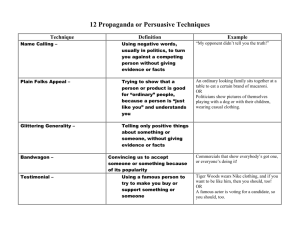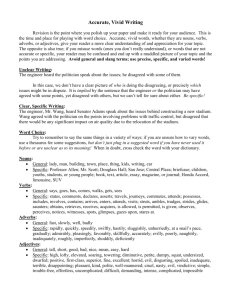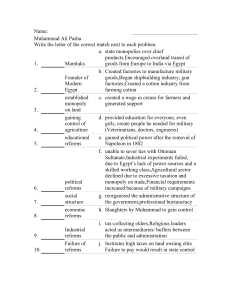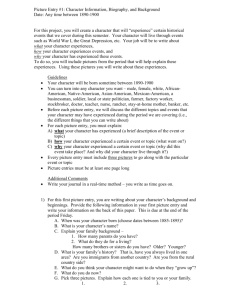Shri Ramesh Ramanathan, Janagraha
advertisement
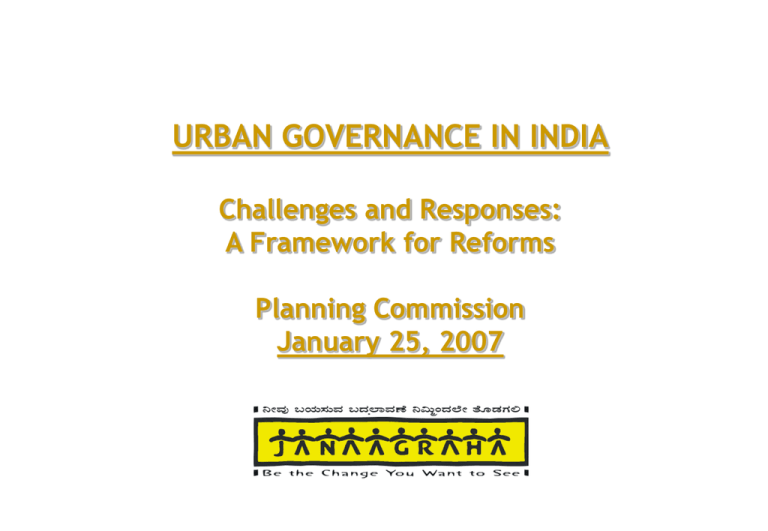
URBAN GOVERNANCE IN INDIA Challenges and Responses: A Framework for Reforms Planning Commission January 25, 2007 Outline •The Urban Context •Views of City Government - different perspectives •The Reality of Urban Governance •Frequently Suggested Solutions •Framework for Urban Governance •Specific Action Agendas •External Factors/ Developments to consider •Benefits of the Framework •Taking it forward The Urban Context •Economic growth closely linked to urbanisation •North America/ Europe were 50% in 1940s, 80% now •Cities the gateways to globalisation •80% of all FDI into China in 1990 went to top 20 cities •Urbanisation a complex process •No controllable set of factors •Policy makers reversing traditional bias •Historical denial of urbanisation beginning to change Views of City Government Urban Poor Special Interest Groups Urban Middle Class City Bureaucrat State Bureaucrat Community Based Orgns ParaStatal Agency NGO TypeB City Politician NGO TypeA State Politician Infrast’ure Players National Politician Multi/ Bilateral Agencies Business Community Opinion Leaders Media •Constant vulnerability •Anchor of city services •Want legal housing •Forced often to seek political patronage Views of City Government Urban Poor Special Interest Groups •Minimal authority •High expectations •HR challenges •Too much political interference •Too many agencies •2-year tenure City Bureaucrat Urban Middle Class State Bureaucrat Community Based Orgns ParaStatal Agency NGO TypeB City Politician NGO TypeA State Politician •Minimal understanding Infrast’ure of the system Investor •Made to feel political irrelevant •High level of agitation, no avenues to engage •Poor often seen in adversarial terms •Low opinion of political representatives Multi/ Bilateral Agencies National Politician Business Community Opinion Leaders Media •No authority to make decisions •Complex system •Too much interference from higher political players •Move on to next level •Look out for myself •Aggressive approach to procure rights for marginal communities •Adversarial attitude towards business and development Views of City Government Urban Poor Special Interest Groups •Too many changes required •Too many legacy institutions •No possibility of dramatic change •Torn about decentralisation City Bureaucrat Urban Middle Class State Bureaucrat Community Based Orgns ParaStatal Agency NGO TypeB City Politician NGO TypeA State Politician Infrast’ure Investor •Demands for infrastructure •“End justifies the means” •Less patience for long-term reform Multi/ Bilateral Agencies National Politician Business Community Opinion Leaders Media •Frustrated by urban management •Decentralisation only to my level •Opportunities for strengthening base •Mixed knowledge of urban issues •Difficulties in maintaining grassroot energies •Challenges to network, scale, sustain Views of City Government Urban Poor Special Interest Groups City Bureaucrat Urban Middle Class •Issue-based advocacy (environment/ heritage/ disabled etc.) •Often removed from core reform discussions •Mixed approach to other stakeholders State Bureaucrat Community Based Orgns ParaStatal Agency NGO TypeB City Politician NGO TypeA State Politician Infrast’ure Players •Focus on service options and pricing •Partial ability to influence reforms •Weak grassroot/ public support Multi/ Bilateral Agencies National Politician Business Community Opinion Leaders Media •Mixed knowledge of urban challenges •Focus on visible changes e.g. “keep my street clean” •Incomplete solutions for change Views of City Government •Reform-oriented at the expense of being marginalised •Collaborative attitude causes confusion •Frustrated at pace of change Urban Poor Special Interest Groups City Bureaucrat Urban Middle Class •Fuzzy accountability to city government and citizens •Relief to have freedom -“Let me run” attitude •City governments do not have expertise to manage services State Bureaucrat Community Based Orgns ParaStatal Agency NGO TypeB City Politician NGO TypeA State Politician Infrast’ure Players •Project-based approach •Increasing recogniition of need for reforms Multi/ Bilateral Agencies National Politician Business Community •Watching and reporting the tamasha! Opinion Leaders Media •Little opportunity to bring real change •Frustrated at people’s expectations •Personal interest in specific projects •Minimal impact on reforms The reality of Urban Governance •Enormous Day-to-Day Challenges •Solid waste management – thousands of tonnes/day •Water supply •Sanitation systems and treatment plants •Multiplicity of agencies •Ad-hoc measures of past left behind legacy problems •Genuine technical skills issue with local government •New ideas need new skills •PPPs/ Outsourcing/JV Agreements use complex contracts •Creation and monitoring of Service-Level Agreements difficult for local govt •Rapid economic activity •Urban growth running faster than solutions can catch up •Very little reliable data being generated to track this The reality of Urban Governance •Urban poverty issues • Multiple factors: land rights/ permanent and seasonal migration/ beneficiary identification •Multiple institutional jurisdictions (example: basic services with local government; public distribution system/housing with state departments) •Weak administrative systems •Weak human resources with minimal training •Poorly designed Cadre and Recruitment Rules •Dysfunctional internal systems – finance, land records, personnel etc. •Massive financial requirements •Rs 28,000 crores/annum for the next 10 years for urban infrastructure •Minimal support from centre/states •Rural-urban issues •Urban growth primarily at fringes •Complex Governance and equity challenges Multiple factors impacting Urban Change Many factors contribute to shaping vibrant cities* No. Factor 1 Effective decentralisation of government functions 2 Efficient Financial Management Systems 3 Defining and monitoring Service Levels 4 Adequate provision of well-located low-income housing 5 Relevant and rapid infrastructure provisioning 6 Efficient collaboration between different agencies 7 Institutionalised Citizens' participation 8 Uniform demarcation of administrative jurisdictions 9 City planning recognising economic/environmental factors 10 GIS for Spatial Information Management 11 Guaranteed Land Title System 12 Effective Zoning. Land-Conversion and Enforcement Policies 13 Efficient Land Market Assessment process 14 Periodic regional economic mapping 15 Regularly updated and centralised Land Records System * “White Paper on Sustainable Cities”, Swati Ramanathan Multiple factors impacting Urban Change Factors have inter-dependencies among them: No. Factor No. of Dependents* No of Dependencies* 1 Effective decentralisation of government functions 7 4 2 Efficient Financial Management Systems 6 8 3 Defining and monitoring Service Levels 7 6 4 Adequate provision of well-located low-income housing 6 12 5 Relevant and rapid infrastructure provisioning 2 12 6 Efficient collaboration between different agencies 12 7 7 Institutionalised Citizens' participation 7 6 8 Uniform demarcation of administrative jurisdictions 8 2 9 City planning recognising economic/environmental factors 5 10 10 GIS for Spatial Information Management 9 1 11 Guaranteed Land Title System 6 3 12 Effective Zoning. Land-Conversion and Enforcement Policies 4 9 13 Efficient Land Market Assessment process 7 8 14 Periodic regional economic mapping 5 7 15 Regularly updated and centralised Land Records System 8 4 *: shows the degree of inter-dependence between factors Need for a Comprehensive Framework for Reforms •Many inter-dependent factors •Difficult to un-bundle reforms •Reforms cannot be separated from institutions •Recognition of the process of change •High price to pay for incomplete/insufficient reforms •Slower national economic growth •Poorer quality of life for citizens •Multiple approaches to change •“This is how change happens” •“Can we be more efficient in how we manage this?” •Purpose of a Comprehensive Framework •Pull all reform ideas together •Suggest Action-Steps to move forward A Framework for Urban Governance The entire Metropolitan Region as the footprint of governance METROPOLITAN PLANNING COMMITTEE REGIONAL SPATIAL DATA CENTRE METROPOLITAN TRANSPORT AUTHORITY CONCERNED PARA-STATALS, SPECIAL-PURPOSE VEHICLES, STATE GOVT DEPARTMENTS CONCERNED LOCAL GOVERNMENTS RURAL TALUK /ZILLA PANCHAYATS URBAN URBAN LOCAL GOVERNMENTS GRAMA PANCHAYATS WARD COMMITTEES GRAM/WARD SABHAS AREA SABHAS LAW & ORDER EDUCATION PWR DISTRIBN. REVENUE PUBLIC HLTH INDTL. DEVMT. PLANNING & ZONING WOMEN & CHILD W’FARE ECONOMICS & STATISTICS WATER & SANITATION ENVIRONMENT & FORESTRY URBAN POOR SERVICES ALL PUBLIC TRANSPORT AGENCIES (BUS/RAIL/AIR/TAXI/ AUTO/RTO etc.) Key Elements of the Framework •Recognition of Regional Footprint beyond local govts •Metropolitan Planning Committee, as per Article 243ZE of COI •MPC spans rural and urban areas •DPC substitutes for MPC in less urban regions •Decentralisation to Local Governments •Supported by appropriate accountability mechanisms •Synchronisation of rural/ urban structures •Establishment of co-ordination mechanisms •Between para-statals and local governments •A realistic alternative to complete absorption of agencies •Ensure Accountability of Local Governments •Formalised Community Participation •Disclosure Specific Action Agendas 1 REGIONAL SPATIAL DATA CENTRE 10 METROPOLITAN PLANNING COMMITTEE METROPOLITAN TRANSPORT AUTHORITY 4 X 3 CONCERNED LOCAL GOVERNMENTS 2 RURAL CONCERNED PARA-STATALS, SPECIAL-PURPOSE VEHICLES, STATE GOVT DEPARTMENTS LAW & ORDER URBAN PWR DISTRIBN. 9 TALUK /ZILLA PANCHAYATS GRAMA PANCHAYATS GRAM/WARD SABHAS URBAN LOCAL 6 GOVERNMENTS WARD COMMITTEES AREA SABHAS EDUCATION REVENUE PUBLIC HLTH INDTL. DEVMT. PLANNING & ZONING WOMEN & CHILD W’FARE ECONOMICS & STATISTICS WATER & SANITATION ENVIRONMENT & FORESTRY 2 5 7 ALL PUBLIC TRANSPORT AGENCIES (BUS/RAIL/AIR/TAXI/ AUTO/RTO etc.) 9 URBAN POOR 8 SERVICES X ALL RELEVANT REGULATORY AUTHORITIES 3 9 Specific Action Agendas 1 •Permanent MPC, with coordination powers •Constitution with Elected Representatives and Experts •Master Planning Procedures and Technical Groups 2 •Completely revamped Municipality Law •Direct Election to Mayor •3-tier structure of Municipality/ Ward Committee/Area Sabha •Formal Citizen Participation in Municipal affairs •Mandatory quarterly disclosure of performance 3 •Co-ordination mechanisms on all Municipal Services as per Schedule XII (and Schedule XI) •Alignment of Jurisdictions based on Ward Boundaries •Joint Budgeting/ Reporting cycles Specific Action Agendas 4 •Establishment of Spatial Data Centre •Real-time GIS for planning and coordination across agencies 5 •Establishment of Integrated Transport Authority •Planning and coordination across all Public Transport Agencies 6 •Implementing Muncipal Reforms at City-level •Financial Reforms in Budgeting, Accounting, MIS •HR and Capacity Building 7 •Urban Land Reforms •Simplified Land Records Management •Guaranteed Land Title Specific Action Agendas 8 •Integrated Services for the Urban Poor •Provision of Low-Income Housing •Other Urban Poor Programmes 9 •Defining and ensuring service outcomes •Establish qualitative and quantitative benchmarks •Management and Monitoring Processes •Equitable outcomes for the poor 10 •Development & Delivery of Comprehensive City Plans •Regional Fooprint •Involvement of multiple stakeholders •Creation of appropriate infrastructure •Rigorous enforcement – e.g. zoning/land-use •Regular mapping/monitoring of economic activities in the city External Factors/ Developments to Consider •Announcement of JNNURM •Substantial Financial Incentive for Urban Reforms •Reforms include 2 3 6 9 •Additional Financial Support for Urban Poor Programmes 8 •Funding support for E-Governance Initiative •Spatial Data Centre Establishment 4 •Major Disruptive Transport Initiatives in most cities •Airports & Mass Transit Systems not as Integrated Transport 5 Benefits of the Framework •Provides a complete response to urban challenges •Captures most solutions being aired •Recognises regional and rural-urban issues •Applies across a state, rather than a specific city •Identifies the specific changes that are required •Integrates all current national initiatives and trends •Allows for prioritisation of reforms and timelines Thank You
